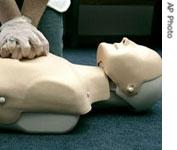VOA慢速英语 2008 0507a
时间:2019-01-11 作者:英语课 分类:VOA慢速英语2008年(五)月
Health Report - How to Do 'Hands-Only CPR'
The American Heart Association simplifies its guidelines for lifesaving action when a person's heart stops. Transcript 1 of radio broadcast:
06 May 2008
This is the VOA Special English Health Report.

Chest compressions on a CPR training dummy 2
Cardiopulmonary resuscitation 3, or CPR, is help for a stopped heart. It increases the chances of survival and reduces the danger of brain damage. With traditional CPR, you push hard on the chest thirty times, then stop to give two breaths to force air into the lungs. You repeat the steps until the victim can get medical treatment.
But people may worry about getting sick from blowing into a stranger's mouth. Also, the training is easy to forget, especially in a crisis. And those without training may be afraid to do anything for fear they will do something wrong.
So now, the American Heart Association has simplified its guidelines and is calling for hands-only CPR. Here is how it works.
A person has collapsed 5 and is unconscious. The victim has lost color in the face and does not appear to be breathing. These are signs of cardiac arrest -- and this is the time to begin CPR.
Place your hands, one on top of the other, on the center of the chest. Push hard and fast. Aim for a rate of about one hundred presses in a minute. Chest compressions keep the blood flowing to the brain, heart and other organs.
CPR guidelines from two thousand five said only untrained people should use this method. Those with training were told to use traditional CPR. But now the American Heart Association says everyone should use hands-only CPR unless they feel strong about their ability to do rescue breathing.
The organization says the hands-only method was just as effective as traditional CPR in several studies. Scientists say there is enough oxygen remaining in a person’s system for several minutes after breathing stops. They also say people need less oxygen when the heart is at rest.
The American Heart Association recommends hands-only CPR for use on adults who suddenly collapse. It says traditional CPR with a combination of breaths and compressions should be used for babies and children. Traditional CPR should also be used for adults who are found already unconscious and not breathing normally. And it should be used for any victims of drowning or collapse from breathing problems.
These are all examples of cases where CPR with mouth-to-mouth breathing may be more helpful that hands-only CPR. The American Heart Association says because there are many such cases, people should still learn CPR that includes mouth-to-mouth.
And that’s the VOA Special English Health Report, written by Caty Weaver 6. For a link to more on hands-only CPR, go to voaspecialenglish.com. I’m Mario Ritter.
- A transcript of the tapes was presented as evidence in court.一份录音带的文字本作为证据被呈交法庭。
- They wouldn't let me have a transcript of the interview.他们拒绝给我一份采访的文字整理稿。
- The police suspect that the device is not a real bomb but a dummy.警方怀疑那个装置不是真炸弹,只是一个假货。
- The boys played soldier with dummy swords made of wood.男孩们用木头做的假木剑玩打仗游戏。
- Despite attempts at resuscitation,Mr Lynch died a week later in hospital.虽经全力抢救,但林奇先生一周以后还是在医院去世了。
- We gave him mouth-to-mouth resuscitation and heart massage.我们对他进行了口对口复苏救治和心脏按摩。
- The country's economy is on the verge of collapse.国家的经济已到了崩溃的边缘。
- The engineer made a complete diagnosis of the bridge's collapse.工程师对桥的倒塌做了一次彻底的调查分析。
- Jack collapsed in agony on the floor. 杰克十分痛苦地瘫倒在地板上。
- The roof collapsed under the weight of snow. 房顶在雪的重压下突然坍塌下来。